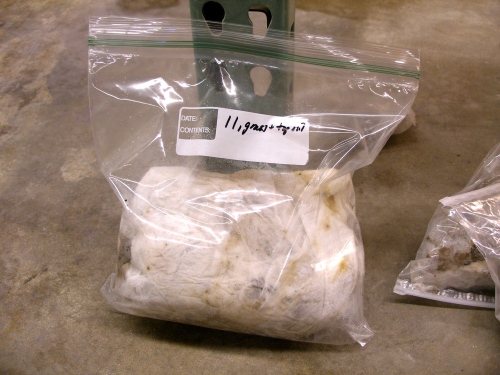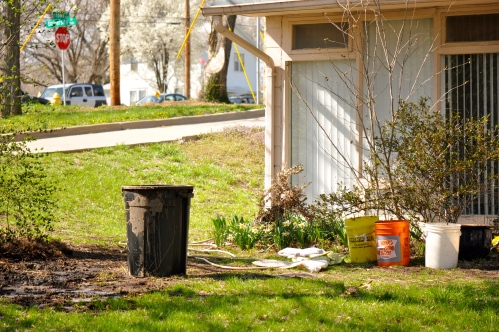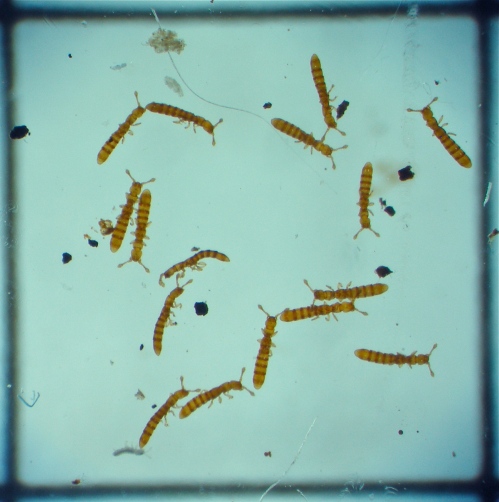Our collection manager Zack and I have been talking about soil washing in Kansas for some time now. Soil washing, for those of you who don’t know, is a technique used to collect insects (in my case) that are subterranean.
In staphylinids, two lineages, Leptotyphlinae and Mayetiini (Pselaphinae) are exceptional in having taken this lifestyle to its extreme and have appreciably diversified in doing so. The two are surprisingly convergent in morphology, although they occupy disparate regions of the rove beetle tree of life.
Zack had heard a rumor that a leptotyphline, one of these subterranean staphylinids, had been collected from a root-ball in a Kansas prairie. Rumor passes down to me, and this rumor was what fueled our motivation to put into action, what is arguably the most tedious method of collecting.
Step 1. You dig. I don’t know, pick a spot, any spot. We chose a variety.

Me, digging for, well… soil, out in Kansas prairie. Photo courtesy of Zack.
Step 2. For this step, you literally wash the soil. I dumped the soil etc. into trash bin and added water with a hose. After a reasonable amount of water had covered the soil underneath, I sloshed the soil around and skimmed off anything that floated to the surface (this is all organic material, including bugs).
Step 3. I then wrapped any organic material I skimmed from the surface of the water into a bundle, using cheesecloth. I then wrung out this organic bundle of any excess water, wrapped it again, this time in paper towels to further dehydrate, and stored them in labeled baggies until Berlese time.

A bundle of organic stuff. The samples can be stored like this for about a week, so you can transport them back from the field if you’re far from home.
Step 4. Berlese time. It only took about a day, the stuff wasn’t very dense.
Step 5. Sort.
To some extent, I think I speak for both Zack and I when I say we had low expectations. This added to our surprise when we found close to 20 individuals of a teeny-teeny staphylinid. We go back and forth for some time about whether it was a leptotyphline or Mayetia, finally settling on the later – I mean they’re so damn convergent-looking!
A little more digging around lead to a species identification, Mayetia pearsei. This species is presumably parthenogenic, argued from the fact that not a single male has been discovered, despite some serious effort. Other species in the genus are known to demonstrate extremely female-biased sex ratios.
Mayetia populations aren’t very dense and individuals are poor dispersers. If chances of meeting a mate are unlikely, this can fuel the establishment of parthenogenesis in a population. In some species where males are present in low frequency, they may play a dwindling role as a population marches on towards purely parthenogenic reproduction. Also possible, males are retained for periodic out-crossing, which theoretically can help avoid pitfalls like Muller’s ratchet and environmental instability. Whatever the case, it seems clear to me that this is an interesting system that deserves more attention; several obvious questions and solutions immediately pop in mind.




Hi, I collect Leptotyphlinae in Italy only in the hills, in the woods at the base of the oldest and most trunks (especially chestnut), very deep.
Unfortunately, I never found the Mayetia ….
Very interesting your account!
By the way, someone is interested in exchanging Pselahpinae?
Regards, Loris
Thanks for sharing your experience. The only time I collected Leptotyphlinae was soil washing in southern-most Texas. I washed the most arid soil imaginable only to my surprise of finding a specimen.
I would be interested in trading away my pselaphines for aleocharines (especially for DNA work and/or material identified to species from the European fauna). I have to say that I think I’ve pretty much given away most of my pselaphines, so the picking might be slim. I can start putting material aside again if there are particular groups that interest you more than others.
I’ve collected them in Italy: You should be able to find them to. They where not that numerous as some places in France, but not that difficult to.
Start with known places and as long it is humid there is no need to go deep or near trunks. Old trees are an indication that the soil is undisturbed. Pay attention to the soil structure: well aerated, never inundated and low altitude.
Taro, it’s been a long time…
For European material: Leptotyphlinae are rounded, Mayetia is flattened. Clear neck and club on the antennae speaks also for Mayetia. Once you’ve seen them a few times it’s easy.
Next step is to check the whole country. Any place can do, but you can higher the chances a lot in undisturbed, humid, never inundated places, mainly forest on rough-sandy soils. You can find also so-called cavernicolous species with this technique.
cool! my impression is that Leptotyphlinae do not have a pronounced antennae club as seen above
I know, super cool! Yeah, the club was what initially lead me to think pselaphine. Once you start looking though, there are a lot of characters that don’t agree with leptotyphlines.